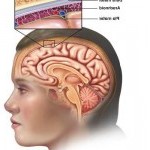Meningitis Symptoms in Children
 Meningitis is a medical term used to describe a disease which causes inflammation of the membrane that surrounds the brain and spinal cord. This can end up into a life threatening disease if proper care is not given when the symptoms first appear. Prolonged illness could result in permanent damage to the brain or other neurological problems and even death in some cases.
Meningitis is a medical term used to describe a disease which causes inflammation of the membrane that surrounds the brain and spinal cord. This can end up into a life threatening disease if proper care is not given when the symptoms first appear. Prolonged illness could result in permanent damage to the brain or other neurological problems and even death in some cases.
Causes of meningitis in children
The inflammation is generally caused by bacterial or viral infection. However, reaction of certain drugs or cancer cells could also be the cause of inflammation. The maximum instances of this disease are in children from the time of birth to the time they reach 2 years of age. However the first 8 months are more crucial.
This disease is caused by a complication caused by infection in the blood stream. The natural barrier called blood brain barrier protects the brain from contamination but in cases of infection in blood, the protective ability is decreased. Once the barrier is breached, the chain reaction starts and infection attacks the fluid which surrounds the brain. The natural action of the body to fight this by increasing the white blood cells could lead to inflammation. With swelling the blood flow to vital parts of the brain decreases.
Bacterial meningitis is caused by the action of different bacteria. After the birth of the child, a group B bacterium is more active. After the child has attained the age of one month a different bacteria called Hib becomes active. However, widespread use of vaccine against Hib has resulted in reduced chances of its attack on the child.
Viral meningitis is caused by viral infection and has flu like symptoms. During summer months the chances of its spreading are more as compared to winter months when the virus becomes relatively dormant. This is less serious as compared to the bacterial infection.
Symptoms of meningitis in children
When a child gets infected he suddenly become seriously ill within a short period of time and if proper care is not taken immediately may result in death. Symptoms displayed by the child depend upon his age as the child cannot communicate and tell about the problem faced by him. The main symptoms are:
- Decreased food and liquid intake
- Vomiting
- Irritability
- Fever
- Bulges on the soft spots of the head
- Seizure
- Neck stiffness and pain. Pain in legs.
- Automatic movement of knees towards body when neck is bent forward.
Treatment
Medical care becomes necessary when the parents have even the slightest doubt about the development of meningitis. Remember that this is a medical emergency and needs immediate care. If possible admission to the emergency room in a hospital should be managed instead of treatment at the clinic of the doctor. Prompt diagnosis and immediate treatment could save the life of the child.
When the child arrives in the hospital all functions of the body are checked. These include fever, blood pressure, and rate of breathing. If the doctor suspects meningitis further tests will be recommended. The most important test conducted to ascertain the existence or non existence of this disease is testing the fluid surrounding the brain or spine. This medical process is done using a syringe. In addition urine test is got done and chest X-ray can also be taken. In extreme cases CT scan can be recommended by the doctor. After the exact cause is ascertained medical treatment will start.
During the time the child is with you and is being transported to hospital or the clinic of the doctor ensure to:
- Give correct quantity of medicine to control fever if high.
- Observe the child minutely to ascertain about deterioration of condition.
- Keep the child comfortable to prevent choking and enable the child to inhale easily.
In case of viral attack the child will be sent home as the viral infection will start to recede in 3-4 days. Ensure that the child takes sufficient quantity of fluid and the fever is controlled by recommended dose of Tylenol. Do not allow other children to come near him and as far as possible keep the utensils of the child separate. Do not use the towel or other clothes used by the child. Above all keep the environment clean and keep the baby in well a ventilated room at a comfortable temperature.